
The Mykleby Family
FOREWORD
Until the summer of 2004, we knew very little about Grandma Dorthea Oppegaard’s ancestry, not
even her parents’ names. She had said that she was born in Østerdalen in east-central Norway;
but we did not know where in Østerdalen Grandma came from.
On maps of the area, we found a small settlement named Mykleby (or sometimes Møkleby) and
within five to ten miles were Myklebysaetra (Mykleby seter), Myklebyskarven and Myklebysjøen
(Mykleby Lake). Not far away was another settlement called Messelt along with Messeltsaetra S.
and Messeltsaetra N. All were in the Stor-Elvdal parish. The close connection between
Myklebys and Messelts in Polk County, Minnesota, (Dorthea’s first husband was Edward
Messelt) suggested that she might have come from that area. But it was only surmise.
Then, at Grace Lutheran Church in Erskine, Minnesota, in July, 2004, we found the marriage
record of Dorthea and second husband John Oppegaard. It showed her birthplace as
“Storelvedalen, Norway.” That confirmed our surmise.
In the Latter Day Saints Church’s genealogical library we found baptism records from Stor-Elvdal,
including those of Dorthea in 1869, her brother Tollef in 1866, sister Olava in 1864 and
sister Gurine in 1861. We did not previously know of the existence of Tollef or Gurine. In each
entry we found the names of the parents: “Halsten Halstensen og Dorthe Olsdtr.”
Searching the LDS database using those names we found other siblings: Hermand, born in 1859,
whom we had not known of before, also Helga, born in 1871, and Oline, born in 1873. And we
found ancestors going back at least to the 17th century–possibly farther.
In the 2004 version of this history, we wrote “With the information we now have, we have a good
chance to add to our knowledge of Dorthea and her family in the future.”–and so it was.
In April of 2005, Ola G. Enger of Norway found our Internet website and wrote that he and I
probably had the same great grandfather, Halsten Halstensen, but not the same great
grandmother. Beyond that, he provided a wealth of information about them and their ancestors.
He sent us an ahnentafel which confirmed our conjectures about the possible 17th century
connection to another line of ancestors going back to Oluf Møkleby, born about 1500. He sent
the first photographs we had ever seen of Halsten and Dorthe and of the area where they lived in
Østerdalen.
Then, in June of 2006, Brit-Lisbet Lund Jonassen wrote that she had been directed to the family
website by Ola G. Enger. Brit-Lisbet said she was the granddaughter of Oline Halstensdatter, a
sister of my grandmother Dorthea. She provided new information about the family which
prompted some revisions in this history–and raised some questions.
We have exchanged many cordial e-mails and I am most grateful to both Ola and Brit-Lisbet for
what they have contributed to our knowledge of the family.
That same year, Rich Germundsen, a seventh cousin once removed, noted that the name we had
shown as Heestad (but could never find) is really Hanestad located on most all maps of the area.
My thanks also to Cedar Rapids genealogist, author and friend from (St. Olaf) college days, Ann
Gesme, for her translations of a host of Norwegian documents.
David L. Scheie
Cedar Rapids, IA
March, 2007
The Mykleby history
The Place
The Mykleby family comes from Østerdalen, Norway’s longest valley, along the Glomma River,
also Norway’s longest, in Hedmark fylke or county in east-central Norway. Hedmark touches
Sweden on the east and Oppland fylke, where the Scheies came from, on the west. Mykleby is
the name of a farm located along the Glomma River in the Stor-Elvdal parish. It is only about 55
miles across a low mountain range southeast from the Skeie farm in Gudbrandsdalen.

In the mid-17th century, Mykleby was in the Åmot parish, but the parish was divided in 1873 and
Mykleby became part of the Stor-Elvdal parish. Some ancestors are buried at the Stor-Elvdal
church as we will note.
Mykleby–like Scheie, Fosmark and Oppegaard--has been spelled several ways. The earliest
known spelling was Micleby as shown in the census or tax list of 1528, the first known document
following the Black Death.
In 1578, the name is shown as Myckelby, then as Møkleby in 1593, as Møcklebye in 1604,
Nøchlebye in 1667 and Møckelbye in 1723. Many 19th century maps show it as Møkleby and it
became Mykleby during the late 18-hundreds.
The name comes from Mykill or Myklibir or Mykliby. Mykill means large--and by or bir means
farm: large farm.
.gif)
Until 1619, Mykleby was comprised of five smaller farms: Evenstad, Akselstu, Trøen, Knuds and
Søstumoen or Møen. Evenstad, the largest of the five, was on the east side of the Glomma River;
the others were on the west. On May 5, 1619, Evenstad was separated from Møkleby and
became independent; the others remained as a single taxable unit. Søstumoen was later split again
into several farms, including Rognstad.
The people:
Oluf to Tollef and Ragnhild
We can trace two branches of what we now call the Mykleby family back to the late 15th century,
almost as far back as the Oppegaards. Many Norwegian family records date back to that time
when Europe was recovering from the devastation of the Black Death–when family record-keeping
resumed after having been largely abandoned.
The family tree is broad as well as tall and therefore easier to follow with diagrams as well as
narrative. We will divide the tree into several segments.
(Many of the names in the family have two or more spellings which vary depending, perhaps, on
the custom of the time. As far as possible, we will use the names as they appear in the records.)
The oldest known ancestor in the Mykleby family is Oluf or Oloff, born about 1500. His name is
recorded in the census or tax list of 1528; he and eleven other taxpayers were assessed 12
skillings each.
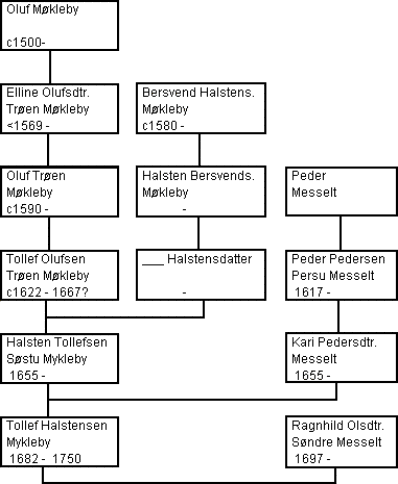
We know little else about him–his
parents or spouse(s). He had a
daughter, Elline Olufsdatter Trøen
Møkleby, born before 1569, who, as
her name indicates, lived at Trøen in
1619 when the Møkleby farm was
divided. The records of that time
describe her as a widow.
She had at least one son, Oluf
Trøen Møkleby (c1590 - ). Oluf
lived at Trøen from 1611 to 1622
and had at least three sons:
The first, Erik, was born about 1611
and in time took over Nystu
Møkleby, a new farm formed by
dividing Trøen in two.
Gjermund Olufsen Trøen Møkleby
was born about 1616 and lived at
Trøen. His wife was probably
Gjertrud Gunnarsdatter.
The third son, our ancestor, Tollef
Olufsen Trøen Møkleby, was born
about 1622 and died in 1667.
At the time Elline Olufsdatter was living at Trøen, Bersvend (or Bersvein) Halstensen
Søstumoen Møkleby lived at Søstumoen. He was probably born between 1560 and 1585.
Bersvend had a son, Halsten Bersvendsen Søstumoen Møkleby, who was born before 1600 .
Halsten succeeded his father as the operator of the farm in 1619 and died some time after1623.
Halsten’s daughter, whose given name and date of birth we do not know, married Tollef Olufsen
Trøen Møkleby who was born, as we noted, about 1622. At some point, Halsten’s daughter
inherited Søstumoen Møkleby and she and Tollef moved there.
In 1655, Tollef and the daughter of Halsten had a son, Halsten Tollefsen Søstumoen Møkleby.
There are conflicting reports as to whether the boy’s father, Tollef, died in 1657 or 1667 when he
would have been about 51, but after his death his widow married Tarald Andersen who operated
the farm until Halsten was old enough to do so.
Tollef’s father, Oluf Trøen Møkleby, also died in 1667 at Søstumoen Møkleby.
Both Tollef Olufsen and his son Halstein Tollefsen were among the men from Møkleby and
Stor-Elvdal who got into a nasty 79-year spat with some Gudbrandsdalers from Øyer over fishing
rights in Møklebysjøen (Møkleby lake). Although the lake is on the Hedmark side of the border,
on the east side of the mountain range, it is about halfway between Øyer and Møkleby.
The dispute began in 1650 when the men from Øyer fished in the lake allegedly without the right
to do so. After being challenged, the invaders withdrew and the Stor-Elvdalers, including Halsten
Tollefsen, went to court to establish their right of control over the lake and its fishing rights.
Tollef Olufsen died in 1667, but seven years later, in 1674, when son Halsten was about 19, the
Gudbrandsdalers returned, bringing with them nets and a variety of other gear. Word spread
among the Stor-Elvdalers who organized and arrived at Møklebysjøen as the men from Øyer were
setting their nets.
The men scuffled with poles and packs and finally with axes. After an hour, the Stor-Elvdalers
retreated.
Only one man, Gudbransdaler Oluf Bjerke, was reported injured and a year later he died, allegedly
from a bump on the head he received during the scuffle at the lake. A trial was scheduled, then
postponed and never resumed.
The dispute continued, however. Finally, more than fifty years later, in 1729, a royal edict
directed farmers on both sides to meet and decide on a boundary–and they did. No further
violence was recorded.
In the year of the Møklebysjøen scuffle, 1674, a large flood occurred along the Glomma River.
Not only did it destroy most of the four tonnes of grain which had been harvested the year before
on the Møkleby farms, it also washed away a large part of the fields on which the grain had
grown. The water created deep gullies and brought in a lot of sand and gravel making it difficult
to raise horses and cows as before.
A meeting of farmers was held to assess the damage and decide what to do about it. Their
decisions are not known.
Halsten Tollefsen Søstu Møkleby married Kari Pedersdatter Perstu Messelt (c1655 - )
in about 1685. (Messelt, too, has had several spellings: Møiszett, Mossett, Melszel, Meeselt and
probably others.)
Her grandfather was Peder Messelt, birth date unknown. Peder was the church warden in
1638-39 and the first known farmer on Perstu Messelt.
His son, Kari’s father, was Peder Pedersen Perstu Messelt, born about 1617. In addition to
Kari (more on her below), Peder had at least five other children:
Ragnhild, born about 1645, married, was widowed, then married Erik Bersvendsen Hanestad and
died in 1738.
Peder, born about 1652, married Ingeborg Andersdatter. They had no children and took in Peder’s
younger brother Gjetvold. When Peder died in 1729, his brother Gjetvold took over the
farm.
Simen, born about 1657, married Siri Gjermundsdatter Trøen Møkleby.
Gjetvold took over his brother Peder’s farm when the latter died in 1729. Gjetvold died in 1737.
The youngest, Marit, married Nils Andersen Nordstu Westgård.
Kari and Halsten Tollefsen Søstu Møkleby had at least four children:
Tollef Halstensen Møkleby, born about 1682; more on him later.
Tarald was born about 1685. He married Kari Jonsdatter Aasen and moved to Aasen in Haltdalen.
Tarald died in 1764.
True married Haagen Olsen Kroken.
Siri married Ole Taraldsen Øvergård and died in1739.
While raising those four children, Halsten bought Søstu Møkleby from a Margareta Jespersdatter
in 1691.
Tollef Halstensen Møkleby married Ragnhild Olsdatter Søndre Messelt, born in 1697, whose
lineage we will now trace.
Tollef to Ragnhild Olsdatter and Tollef Halstensen
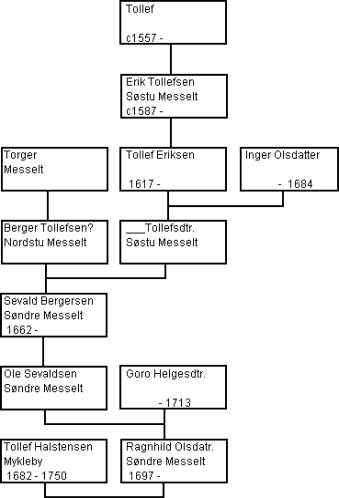
From the name Erik Tollefsen Søstu Messelt, we can deduce his father was named Tollef–and that’s all we know.
Erik had a son, Tollef Eriksen, born in 1617, so presumably his father Erik was born about 1587 and his grandfather Tollef about 1557.
Tollef Eriksen married Inger Olsdatter ( - 1684) and they had a daughter whose given name we do not know.
The daughter married a man whose name is reported as Berger Tollefsen Nordstu Messelt. We say “reported” because in some records his father’s name is given as Torger Messelt, but if that were so, the son’s name would be Berger Torgersen Nordstu Messelt.
At some point, Berger apparently took over Søndre Messelt, married an otherwise unidentified daughter of Tollef Eriksen and with her had a son, Sevald Bergersen Søndre Messelt, born in 1662.
We do not know the name of his spouse, but Sevald had a son, Ole Sevaldsen Søndre Messelt.
Ole married Goro Helgesdatter ( - 1713) and they had at least one child, Ragnhild Olsdatter Søndre Messelt, born in 1697. After Goro’s death, Ole married again. He had a total of ten children.
In 1723 Ole took over at Søndre Messelt, succeeding his parents. A record of the transfer shows
that the farm then had 3 horses, 20 cattle, and 30 sheep; that 28 loads of hay were cut and 7
measures of mixed grain were planted. The farm had its own grain mill and a part-interest in a
sawmill which produced firewood, fencing and building lumber. The land was only lightly farmed
and had a lot of sand and gravel from frequent high water on the Glomma River. The houses, too,
were susceptible to flooding.
Tying two lines of the family together, Ragnhild Olsdatter Søndre Messelt married Tollef
Halstensen Møkleby and they took over Søstumoen Møkleby from his mother, Kari
Pedersdatter, in 1752. Records show that the taxes on the farm were greater than on any other
farm in the region except for Koppang and Strand.
Tollef and Ragnhild had at least one son, Halsten Tollefsen Søstu Møkleby, born about 1727.
Halsten married Ingeborg Taraldsdatter Trønnes on June 29, 1752. They were married at
Åmot, about 20 miles to the south. Ingeborg was born in 1724 and here we bring in another
sizeable branch of the family going back five generations.
-0-
(Note: Rich Germundsen has written that the settlement I had named “Heestad” in earlier
editions of this history was really, shown in bygdebøker and current maps as “Hanestad.” I
found the same. Google, for example, has 872 listings for Hanestad; just one, our website,
showed Heestad.
Hanestad is located in Østerdalen about 30 miles (50 kilometers) north of Mykleby. Heestad
could not be found.
At this date I am still trying to determine how Heestad came to be used in some earlier
documents we used including some from Norway. Might it have been a more ancient name, for
example?
I should also note that the name Hanestad has appeared in previous editions of this history. In
the section headed “Oluf to Tollef and Ragnhild” Ragnild Pedersdatter Perstu Messelt (1645-1738)
is reported to have married Erik Bersvendsen Hanestad.
It should be kept in mind that words like Heestad, Hanestad, Scheie and Oppegaard were not
family names in the Norwegian patronymic system, but were addresses, usually farm names.
Hence, Erik Olufsen Hanestad should be understood as Erik, son of Oluf, of Hanestad.).
Oluf to Ingeborg and Auden to Tarald
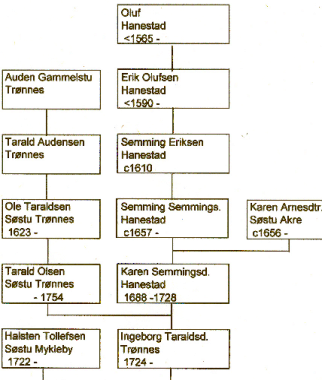
This branch starts with Oluf Hanestad
who is mentioned in records in 1575.
He is described as probably the first
farmer at Nedre Hanestad in Rendalen,
about 25 miles north of Mykleby.
His son was Erik Olufsen Hanestad who
is identified as the farmer at Hanestad
from1629 to 1632.
His son was Semming Eriksen Hanestad
who is named as a cotter (hussman med
jord) on a farm under Hanestad in 1633.
He had a son, Semming Semmingsen
Hanestad , born about 1657.
Semming inherited some land from a ”mother Ingeborg,” possibly his own
mother, which he had leased. In 1687, he
“redeemed” all of his sons-in-law.
The records also show that in 1680 he was robbed by the famous robber Haagen Gudbrandsen Otnes.
In 1691, Semming, together with a Bersvend Upper Hanestad claimed the right to “Myrjernblæster
from Bybselsæte I Lilleelvdalen to Graahøgsdaasen.” (Said to be Old Norse
which we hope to decipher.)
Semming married Karen Arnesdatter Søstu Akre who was born about 1656.
One of their children was Karen Semmingsdatter Hanestad (1688 - 1728) who married
Tarald Olsen Søstu Trønnes whose family goes back three earlier generations.
As for Auden to Tarald, we know little beside their names: the first was Auden Gammelstu
Trønnes.
His son was Tarald Audensen Trønnes.
His son was Ole Taraldsen Søstu Trønnes who was born in 1623.
His son was Tarald Olsen Søstu Trønnes who, as mentioned just above, married Karen
Semmingsdatter Hanestad.
They had a daughter, Ingeborg Taraldsdatter Trønnes, who, as mentioned earlier, married
Halsten Tollefsen Søstu Mykleby.
Halsten and Ingeborg had at least one son, Tollef Halstensen Søstumoen Mykleby, born July
29, 1753.
Tollef married Ragnhild Helgesdatter Søstu Stai, (1759 - ) on June 23, 1777, also at Åmot,
whose history we trace next.
Ole to Ragnhild and Tollef
Ragnhild’s earliest known ancestor was Ole Sollien, born in 1610.

His son Ole Olsen Sollien, (1650 - 1726) is described as one of the first pioneers at Sollien, possibly having moved there with his father. He married Kari Hesdatter (1662 - 1746).
Their son was Helge Olsen Søstu Stai. In 1676, Søstu Stai was divided into two equal parts-- one was farmed by Helge and the other by Halsten Olsonner, probably brothers. But in 1684, Stai is again one farm and the farmer is Helge.
Helge’s son was Ole Helgesen Søstu Stai ( - 1737). All we know of him is that he married Karen Sevaldsdatter who died in 1717.
Their son was Helge Olsen Søstu Stai (1710 - 1762). He married Siri Tollevsdatter Hornset (1715-1762), whose father, Tollev Hornset (1686 - 1764), was a sheriff in Ytre Rendal from 1732
until his death in 1764.
A sheriff was an important local official, responsible for, among other things, arresting criminals,
collecting fines, insuring the accuracy of weights and measures, keeping roads open in winter and
notifying the judge of deaths. He was appointed apparently by the crown and the job was
sometimes passed from father to son.
Possibly through the connection with his father-in-law, Helge became a sheriff in neighboring
Stor-Elvdal and received a pension in retirement. He also inherited 836 riksdaler from his
parents’ estate and, with good management or luck, his and Siri’s estate grew to 2828 riksdaler at
the time both died in 1762.
We don’t know how many children they had, but among them was Ragnhild Helgesdatter
Søstu Stai (1759 - 1848). Ragnhild inherited 218 riksdaler on the death of her parents and other sums
from grandfather Tollef Hornset and from her sister Kari who never married and died in 1768.
Ragnhild married Tollef Halstensen Mykleby whose ancestors we traced earlier.
They had six children:
Halsten 1780
Ingebore 1783
Helge 1787
Siri 1792
Ragnil 1796
Kari 1798
The oldest, Halsten Tollefsen Mykleby, was christened June 4, 1780, at Stor-Elvdal. On
October 9, 1815, he married Guri Haagensdatter Akselstu whose extensive family goes back six
generations to the early 17th century.
Semming to Guri
Semming Furuset (also called Simen) is the first known farmer at Furuset; records show he was
there as early as 1632 and at least until 1649. In that latter year, Furuset, which had been a crown
farm, was sold by King Fredrik III to a customs officer in Oslo.
Semming married a woman named Kirsten. All we know of her is that she was listed as a
witness in a lawsuit in Kroken in 1653.
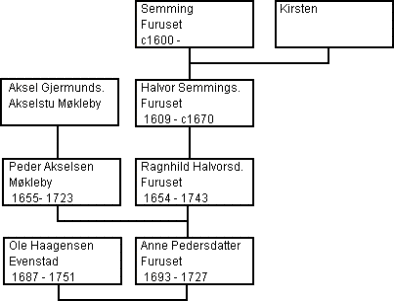
They had a son, Halvor Semmingsen Furuset (1609- c1670). He owned 3 horses, seventeen cows and was helped by a cotter. The farm was located in the flood area along the river, but Halvor also had a forest and cut lumber.
His wife’s name is not known but it is recorded that after Halvor’s death she married Engebret Akselsen Akselstu Møkleby.
Before that, Halvor and his wife had at least one child, Ragnhild Halvorsdatter Furuset (1654 - 1743).
Ragnhild married Peder Akselsen Møkleby, the son of Aksel Gjermundsen Akselstu Møkleby (1574 - 1670), at the age of 96. Aksel farmed at Akselstu until he was 93.
The record shows that Peder and Ragnhild’s Møkleby farm had 2 horses, 16 cows, 20 sheep and
21 loads of hay. It was located at Sollien on low land, subject to flooding.
Peder and Ragnhild’s oldest daughter was Anne Pedersdatter Furuset (1693-1727) who
married Ole Haagensen Evenstad (1687-1751).
Ole was the grandson of Tarald Gjetvoldsen Deset who married Kari Olusdatter Evenstad.
Their son was Haagen Taraldsen Evenstad (1655-1723). He obtained a lease on some farm
land and, with an uncle, purchased more. This joint arrangement resulted in much quarreling.
Haagen married Kari Pedersdatter Strand (1649-1745). She and two grown children managed
a farm in Evenstad until the owner, Halvor Olsen, died and then inherited it from him.
Haagen and Kari had a son Ole Haagensen Evenstad, described as “an unassuming and religious
man,” referred to earlier as the husband of Anne Pedersdater Furuset.
Ole and Anne had a daughter, Kari Olsdatter Evenstad (1719-1773). She married Ole Nilsen
Strand (1703-1763) whose ancestry goes back three generations.
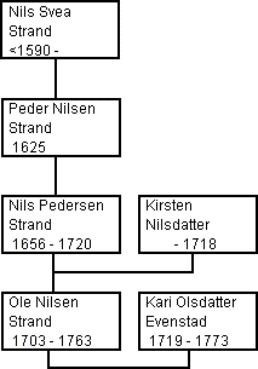
Nils to Ole
Ole’s great-grandfather was Nils Svea Strand who was the church warden from 1616 to 1622 and must have lived at Svea because his son, Peder Nilsen Strand, was the farmer there in the 1660's.
Peder’s son was Nils Pedersen Strand (1656-1720) who married Kirsten Nilsdatter and together they had eight children. At her death in 1718, she left 176 riksdaler for division among the children. When Nils settled the estate three years later, the children got an additional 125 riksdaler.
Those eight children became the parents of several of what were termed the important and substantial families in Stor-Elvdal.
One of those eight children was the Ole Nilsen Strand mentioned earlier as the husband of Kari Olsdatter Evenstad.
After Kari’s father, Ole Haagensen Evenstad, died in 1740, Ole Nilsen took over Evenstad without a contract or deed and laid claim to both Evenstad and Furuset. Ole Haagensen reportedly thought
Evenstad should go to daughter Guri.
The case went to court and after lengthy testimony was decided in Guri’s favor. However, she
died shortly thereafter and the property went to Ole anyway.
Ole Nilsen Strand and Kari Olsdatter Evenstad had a son, Haagen Olsen Evenstad
(1740-1818) who married a widow, Ingeborg Pedersdatter Sjøli in 1767. She had been
married to Engebret Gjermundsen Akselstu who died at 40. Although they had the misfortune
of losing their farm house in a fire, he left an estate of 877 riksdaler, so apparently had
managed well.
After Haagen and Ingeborg married, Haagen persuaded her children’s guardians to temporarily
lease him their part of Akselstu for 200 riksdaler. The land would revert to them when they
reached majority and they would repay Haagen the 200 riksdaler. In 1793, the farm was sold to
another man who paid 200 riksdaler for the children’s portion and 300 for Ingeborg and Haagen’s
portion.
Haagen and Ingeborg had a daughter Guri Haagensdatter Akselstu, born in 1778, who married
Halsten Tollefsen Mykleby whose ancestry we traced previously.
Halsten and Guri
Halsten died in1832 at the age of 52. After his death, Guri ran Mykleby. She had 7 horses, 50
cows and 57 sheep.
Halsten and Guri had at least four children. The oldest, Tollef, died unmarried in 1840.
The second-oldest, Haagen, born in 1817, took over Mykleby in the 1850's. We know nothing
further about Ragnhild.
.gif) Halsten Mykleby
Halsten Mykleby.gif) Dorthe Olsdatter
Dorthe OlsdatterThe fourth child was our ancestor, my great grandfather, Halsten Halstensen, born in 1821. We
know little of his early life until 1859 when he would have been 38 years old.

The first recorded family event that year was the birth of Hermand or Herman on January 19. His parents were named as Halsten Halstensen and Dorthe Olsdatter.
Dorthe was born May 2, 1836, the daughter of Ole Knudsen Stai and Dordi Knudsdatter, the youngest of their six children. Her brother Ole, born in 1833, was an ancestor of a large family that immigrated to Goodhue and Douglas counties in Minnesota and took the name Stai.
One descendant was Shirley Stai Anderson/Keas with whom we made contact in 2007 and who
told us about this branch of the family.
Dorthe and Halsten Halstensen were not married when Hermand was born in January of 1859. In
fact they did not marry until August 20 of that year, possibly at Åmot where Hermand was
christened the very next day.
We learned about these events of 1859 when Ola G. Enger contact us through our family website
in April, 2005. Ola said both he and I were great grandsons of Halsten, but we had different
grandmothers. He was the great grandson of Halsten and Marte Olsdatter Kildehammer and they
were never married. Church records noted that Halsten and Marte had an “illegitimate child,”
Ole, who later in life took the name Grinaker who was the man whom his mother later married.
Ole was born in 1858, a year before Hermand. Ola said there were stories that Halsten had three
women pregnant at the same time.
Lending credence to this sequence is an 1861 record showing two children of Halsten receiving
vaccinations: Ole’s age was shown as 2 1/3 and Hermand was 1 3/4.
Thanks to Brit-Lisbet Lund Jonassen we now know that Halsten and Dorthe had eight children:
Born Christened At
Hermand January 19, 1859 August 21, 1859 Åmot
Gurine September 15, 1860 January 1, 1861 Stor-Elvdal
Olava February 8, 1864 March 24, 1864 Stor-Elvdal
Tollef August 22, 1866 November 18, 1866 Stor-Elvdal
Dorthea May 8, 1869 August 1, 1869 Stor-Elvdal
Helga April, 1871 July 30, 1871 Stor-Elvdal
Oline May 13, 1873 August 24, 1873 Stor-Elvdal
Ragna May 13, 1873 August 24, 1873 Stor-Elvdal
In the baptism record of Gurine, the parents’ address is given as Søstumoen, but Olava’s and Tollef’s
record shows it as Møkleby. Both probably indicate the same place.
Dorthea’s baptism record show her father’s name as Halstein Halsteinsen Røgnstad. Ola Enger
says Halsten (or “Halstein”) inherited some land from his parents, established Rognstad a mile or
so away and built a home there. In some records his name is shown as “Halsten Halstensen Røgnstad
(or Mykleby).”
Ola sent a picture of the house which is obviously the same as that shown in a photo which my
mother Ellen owned and captioned “My mother’s Home in Norway.” It was almost certainly built
by Halsten.
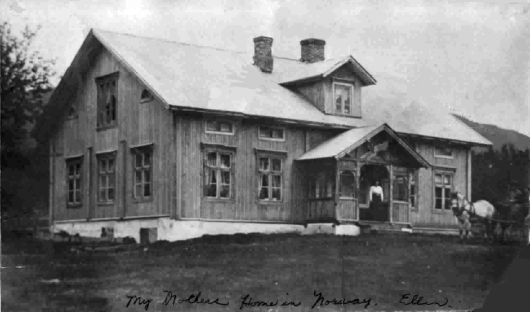 “My Mother’s Home in Norway. Ellen”
“My Mother’s Home in Norway. Ellen”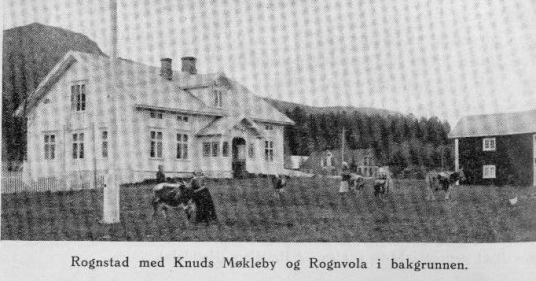 “Rognstad with Knuds Mykleby and Rognvola in the background”
“Rognstad with Knuds Mykleby and Rognvola in the background”The size and appearance of the home suggests that the family was financially comfortable–and had
been so for generations. They were landowners, not cotters, starting with the earliest records.
In the 1865 census, Halsten’s occupation is listed as “Landhandler” and “Stationsholder.” The
former means rural store owner; the latter means he operated a stop on Norway’s public
transportation system of that time. At such a stop, travelers would hire a horse-drawn cart or
carriage to take them from one station to another perhaps ten or fifteen miles away. Someone,
often a teenaged boy, would ride along and bring the rig back to its starting point.
Halsten was also, of course, the owner of a sizeable farm.
In 1971, Goodwin Oppegard’s widow Hazel sent a postcard to Dagny telling of a visit to
Dorthea’s childhood home–and of finding the initials she had carved at Mykleby seter.
The seter, where the farmers would take their cattle in the summer, is located a few miles to the
west, toward the mountains. Ola describes it as a beautiful area for cross-country skiing in the
winter.
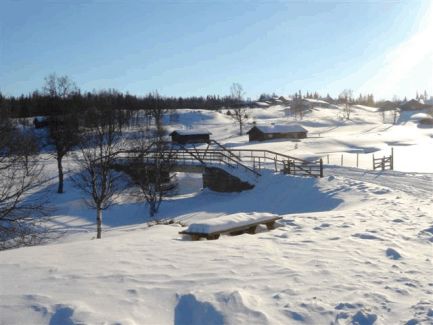 Mykleby seter
Mykleby seter
Rognstad also has a seter in the mountains.
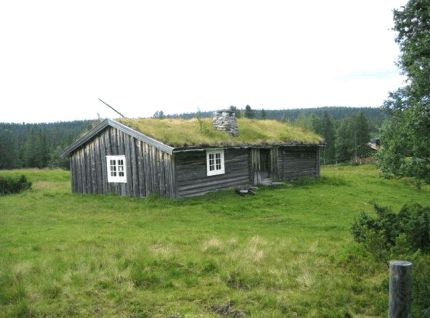 Rognstad seter
Rognstad seter
In the 1880's, the Norwegian emigration to America continued, although not at the peak levels of
the previous decade. For many, particularly in rural areas, the decision to leave was motivated by
having too many people on too little arable land. America offered free fertile farmland to
homesteaders.
But Halsten and his family–as landowners, operators of a rural store and a coaching station–would
seem to have been economically comfortable and well-to-do.
Brit-Lisbet says, however, that at some point Halsten guaranteed a loan for someone who did not
repay and lost Rognstad as a result. We do not know when that happened. Still, the 1901 census
shows that he and Dorthe continued to live at Rognstad and had an annual retirement allowance.
So the economic pressure to emigrate was not severe.
We now know that six of the eight children remained in Norway. Hermand married Kari Jackobsdatter
on January 4, 1881. Gurine, the second child, married Olaf Andreassen on March 16,
1883. Olava married Anton Nilsen of Åmot; they had six daughters and remained in Østerdalen.
Tollef remained but we know nothing more about his life.
Of the twins, Oline married Ole Magnus Lund, a police officer; they lived in Oslo (Christiania) for
forty years and had four children: Bjarne, Harald, Storm and Asbjørn Odvar (1907-1980), the father of Brit-Lisbet.
The other twin, Ragna, worked for a time as a necktie seamstress in Oslo and lived with sister Oline
and husband Ole, but later returned to Rasta in Østerdalen and married Per Skatterud.
So what could have prompted two daughters–Dorthea and Helga–to leave the family when they
turned 18 and sail off to America? Love?
Dorthea left by herself in 1887 a few months after her 18th birthday in May and headed for Polk
County, Minnesota, where others from Stor-Elvdal had settled.
The following year, on June 18, 1888, she married Edward Olsen Messelt, presumably from the
Messelt farm about ten miles from Rognstad and Mykleby. Perhaps they had known each other and
maybe even fallen in love back in Norway.
Dorthea and Edward were married by Polk County Judge of Probate C. O. Christiansen before
witnesses Ingeborg Messelt and Herman Wold.
The marriage ended, however, after less than three years when Edward died May 13, 1891.
A year later, in 1888, Helga turned 18 in April and also sailed to America, probably arriving after
Dorthea’s and Edward’s wedding. But it was not until five years later that Helga was married to
Hooken (Haakon) Messelt by the Rev. J. O. Saeter of the Norwegian Lutheran Synod church in
McIntosh (later served by Iver Scheie) on August 11, 1893. The witnesses were Dorthea Messelt
and Engebret Messelt.
I have been told that Haakon and Edward Messelt were not related, but both probably came from
the farm of that name near Rognstad. Engbret may have been from another family at that farm.
After six years as a widow, Dorthea married widower John Oppegaard on July 8, 1897. They were
married by Rev. Kristofer Dalager, a Norwegian Lutheran pastor. The witnesses were Bernt
Oppegaard and Christine Solberg. For some reason, the wedding was in McIntosh even though
John’s farm was just outside Erskine. Had Dorthea moved to McIntosh some time after Edward
Messelt’s death?
It is also puzzling that on the wedding license, Dorthea’s name is given as Dorthea Olson.
-0-
Until 2006, we had thought that four of the sisters–Dorthea and Helga plus Olava and Oline had
come to America. But Brit-Lisbet Lund Jonassen, a granddaughter of Oline, says her grandmother
and sister Olava remained in Norway.
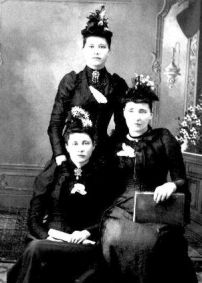 Dorthea (left) and two sisters?
Dorthea (left) and two sisters?
We are then left with questions about a couple of old photographs.
We had thought one showed Dorthea and two of her sisters all of whom seem to to have a strong family resemblance, possibly the twins. But no, the photo was taken by a photographer in Crookston, Minnesota. And since only one sister came to America, who are the other two?
.jpg)
The other photo, also taken in Crookston shows
Dorthea and another woman who could be Helga, but
who knows?
Both pictures were kept by Dorthea but do not carry
identifications.
We may also wonder why Dorthea, at her first wedding, was married by a judge.
Were neither she nor Edward Messelt a
member of a church?
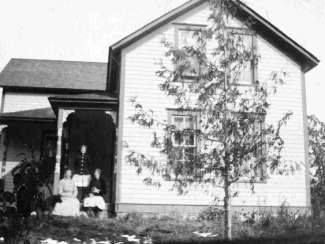 The Oppegaard farmhouse
The Oppegaard farmhouseAfter their marriage, Dorthea and John Oppegaard lived on the land he had homesteaded just southeast of Erskine until his death in September, 1904.
On September 1, 1898, a year after her marriage to John Oppegaard, Dorthea (“formerly Dorthea
Olson” on the land transfer) sold 80 acres of land in Garden township west of Winger to Haakon
Messelt. The acreage was probably where she and her first husband Edward Messelt had made
their home.
We do not know whether or how much Dorthea and Helga kept in touch with their parents and
siblings back in Norway.
But in the years since they left and perhaps before that, their father had become somewhat famous
as a bear hunter. The book Great Hunters in Østerdalen by Sven R. Gjems states Halsten shot 36
bear. This was not sport hunting; bears were threat to both livestock and people.
1.jpg) “Halsten Møkleby on Rognstad in his later days.”
“Halsten Møkleby on Rognstad in his later days.”
Ola Enger tells that when Halsten grew old, his legs were giving out and he had trouble moving
around. At the farm one day, plans were made to slaughter a cow and Halsten sent a young farm
hand to fetch it. When the boy came out of the barn leading the animal, Halsten fired his rifle. Both
the cow and the boy fell to the ground. The cow was dead; the boy had fainted. “Halsten was out
hunting again.”
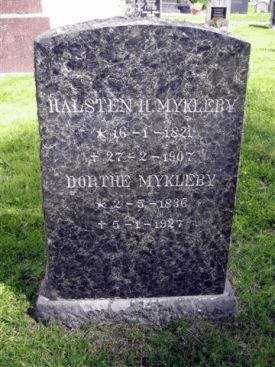
Halsten died on February 27, 1907.
Dorthe lived twenty more years, until January 5, 1927. They are buried together at the Stor-Elvdal hovdekirke.
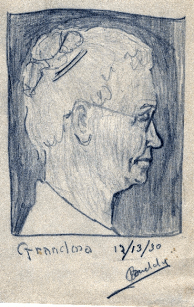 A pencil drawing of
A pencil drawing of“Grandma” probably by
Goodwin “Buddy” Alarik
Meanwhile, in America, the widow Dorthea, her three
step-children and two daughters had moved from the farm near
Erskine into McIntosh. They became members of the United
Norwegian Lutheran Church of which Rev. J. B. A. Dale was
pastor.
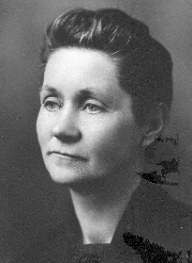 Dorthea Mykleby Oppegaard
Dorthea Mykleby Oppegaard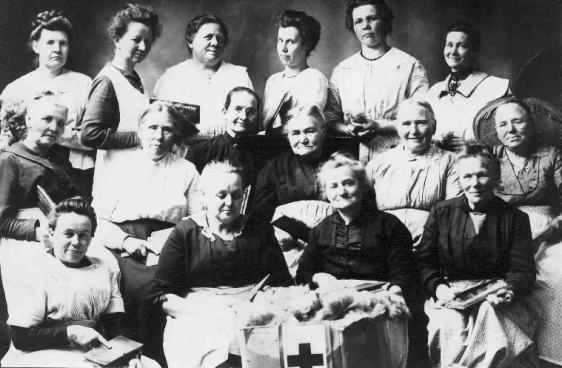 The “McIntosh Beauties”
The “McIntosh Beauties”Dorthea is at the right in the back row. Marie is third from the left in the second row.
Surely she would have known another widow with nine children: Marie Scheie. They were members of different Norwegian Lutheran churches but were both active in a group which called the “McIntosh Beauties.” They may have organized to roll bandages for American troops in World War I.
Neither Dagny nor Ellen went to college, but Ellen attended a secretarial school and worked for a time in Minneapolis. Dagny may have followed a similar path. In time, each of them married. (See Oppegaard and Scheie histories.)
Some time in the late 1930's or early 40's, my parents and I drove to McIntosh, helped sell
Grandma’s house and moved her to our place in Joice where we had plenty of room.
I was too young to fully understand then and it was never explained to me, but I think she either
suffered from depression and/or dementia, and could no longer take care of herself.
I knew her as usually quiet, never boisterous, but one who would converse when encouraged. She
rarely left our house.
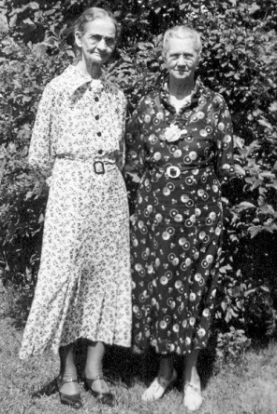 Marie Scheie and Dorthea Oppegaard
Marie Scheie and Dorthea Oppegaard
She was very kind toward me. I remember her talking about her home in Norway–“such a beautiful place.”
But her presence was difficult for my mother. Occasionally, there was a sharp word. From time to time, Grandma would spend some time with Dagny, but those stays were brief and, I understood, difficult for both Dagny and her.
Grandma continued to live with my folks after I left for college–when they moved to Jewell, then to Minneapolis. As she became more feeble, she needed more care than could be provided at home and so she moved to Ebenezer.
My mother spent many hours with her there daily until her death August 11, 1962, at the age of 95.
She is buried next to Ellen and Lod at Crystal Lake Cemetery in Minneapolis.